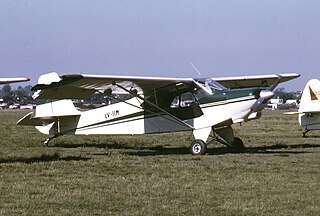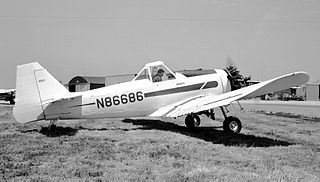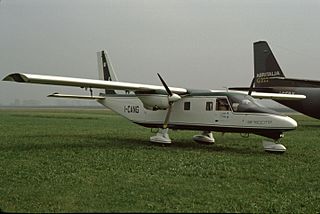Related Research Articles

The IMCO CallAir A-9 is a small agricultural aircraft that first flew in 1962, a development of the company's previous successful crop-dusters. It is typical of aircraft of its type - a single-seat aircraft with a low wing incorporating spraying gear.

The PZL-Mielec M-18 Dromader is a single engine agricultural aircraft that is manufactured by PZL-Mielec in Poland. The aircraft is used mainly as a cropduster or firefighting machine.

The RA-14 Loisirs was a French two-seat high-wing light touring aircraft designed by Roger Adam shortly after World War II.

The PA-25 Pawnee is an agricultural aircraft produced by Piper Aircraft between 1959 and 1981. It remains a widely used aircraft in agricultural spraying and is also used as a tow plane, or tug, for launching gliders or for towing banners. In 1988, the design rights and support responsibility were sold to Latino Americana de Aviación of Argentina.

The Curtiss-Wright X-19, company designation Model 200, is an American experimental tiltrotor aircraft of the early 1960s. It was noteworthy for being the last aircraft of any kind manufactured by Curtiss-Wright.

The PL-11 Airtruck is a New Zealand agricultural aircraft.

The Agusta AZ.8L, or Agusta-Zappata AZ.8L, was an Italian airliner prototype first flown on 9 June 1958. It was of conventional low-wing monoplane configuration with tricycle undercarriage and all-metal construction. Filippo Zappata's design grew out of a twin-engined transport designated AZ.1 that was never built.

The Piaggio P.166 is an Italian twin-engine pusher-type utility aircraft developed by Piaggio Aero. The aircraft model name was Portofino, and is also known as Albatross in South African military service.

The Yeoman Cropmaster was an Australian agricultural aircraft developed from the CAC Wackett trainer of World War II.

The Emair MA-1 Paymaster was a 1960s American agricultural biplane aircraft built by Emair, which was part of the Hawaiian Murray company. The prototype was constructed and flown in New Zealand, with production aircraft built in the United States at Harlingen, Texas.

The DINFIA IA 46 Ranquel, IA 46 Super Ranquel, and IA 51 Tehuelche were Argentine utility aircraft developed in the late 1950s.
The DSK Airmotive DSK-1 Hawk was an unusual homebuilt aircraft designed in the United States in the early 1970s. While the design itself was utterly conventional - a single-seat low-wing cantilever monoplane with fixed tricycle undercarriage - its method of construction was not, since the DSK-1 Hawk used a surplus 200 US Gal military drop tank as its fuselage. Designer Richard Killingsworth sold over 250 sets of plans.

The Elliots Primary EoN or EoN Type 7 S.G.38 Primary was a training glider built in the UK shortly after World War II. It was an absolutely minimalist aircraft, consisting of a high, cable-braced wing connected to a conventional empennage by an open-truss framework, and was a copy of the German SG 38 Schulgleiter. Marketed to aeroclubs, the Primary EoN was also adopted in 1948 by the Air Training Corps and by the Combined Cadet Force under the name Eton TX.1. An example is at the Gliding Heritage Centre.

The Weatherly Model 201 is a 1960s American agricultural monoplane designed and built by the Weatherly Aviation Company of Hollister, California.

The Vulcanair SF.600 Canguro was a feederliner developed in Italy in the late 1970s. Despite a number of attempts to put the aircraft into series production, only a small number were ever built. The Canguro was a high-wing cantilever monoplane of conventional configuration with a fuselage of rectangular cross-section and a high-set tail. The tricycle undercarriage was not retractable, and its main units were carried on sponsons on the fuselage sides. SIAI Marchetti provided funding towards the construction of the prototype, and constructed this aircraft at the former Aviamilano plant. After flight testing proved positive, the type was put on sale, but failed to attract buyers in any number, even when the original piston engines were exchanged for turboprops and retractable undercarriage was offered as an option.

The GY-80 Horizon is a French four-seat touring monoplane of the 1960s designed by Yves Gardan and built under licence, first by Sud Aviation, and later by that company's SOCATA subsidiary.

The PIK-15 Hinu is a light aircraft developed in Finland in the 1960s for use as a glider tug. It was a low-wing cantilever monoplane of conventional design with an enclosed cockpit and fixed, tailwheel undercarriage. The cockpit had two seats, side-by-side, and the PIK-15 was intended to have a secondary role as a trainer. Construction was of wood throughout.

The North American NA-40 was an American prototype bomber aircraft developed by North American Aviation in the late 1930s for evaluation by the United States Army Air Corps. Although unsuccessful, it led directly to the North American B-25 Mitchell medium bomber.

The Larson D-1 was an agricultural biplane that was purpose-built to replace Boeing Stearman cropdusters.

The Aerojet SD-2 Overseer was an unmanned aerial vehicle developed by Aerojet General and Rheem Manufacturing Co. in the late 1950s for use by the United States Army. Built in limited numbers, it never saw operational service.
References
- ↑ Taylor 1965, p.178.
- Taylor, John W. R. (1965). Jane's All The World's Aircraft 1965-66. London: Sampson Low, Marston & Company.
- Taylor, Michael J. H. (1989). Jane's Encyclopedia of Aviation. London: Studio Editions. p. 58.